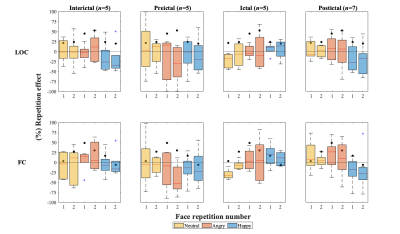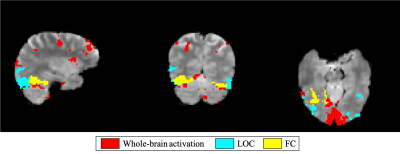Catarina Domingos1, Amparo Ruiz-Tagle1, Ana Fouto1, Inês Esteves1, Raquel Gil-Gouveia2, and Patrícia Figueiredo1
1Institute for Systems and Robotics - Lisboa and Department of Bioengineering, Instituto Superior Técnico, Universidade de Lisboa, Lisbon, Portugal, 2Neurology Department, Hospital da Luz, Lisbon, Portugal
1Institute for Systems and Robotics - Lisboa and Department of Bioengineering, Instituto Superior Técnico, Universidade de Lisboa, Lisbon, Portugal, 2Neurology Department, Hospital da Luz, Lisbon, Portugal
Simulations showed the ability to estimate repetition effects provided that response delays did not significantly deviate from default. In real data, healthy controls exhibited the normal repetition suppression, but patients exhibited response maintenance or even potentiation.

Fig.5: Empirical Results. Repetition effect indexes obtained for each phase of the migraine cycle (columns) and each emotion (colours), in LOC (top) and FC (bottom) ROIs. Boxplots represent distributions across patients, and black circles represent average values from two controls. In general, no RS effects are found in patients. Although not statistically significant, larger deviations (in patients) from normal RS (in controls) are found for angry faces in the interictal and preictal phases.
